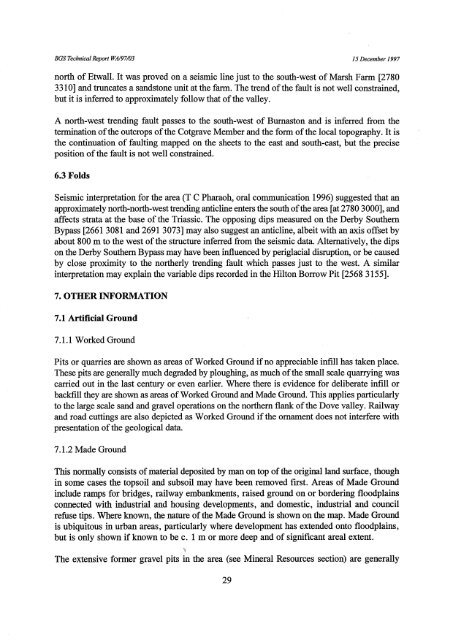Download (3723Kb) - NERC Open Research Archive - Natural ...
Download (3723Kb) - NERC Open Research Archive - Natural ...
Download (3723Kb) - NERC Open Research Archive - Natural ...
You also want an ePaper? Increase the reach of your titles
YUMPU automatically turns print PDFs into web optimized ePapers that Google loves.
BGS Technical Report WM97/03 15 December 1997<br />
north of Etwall. It was proved on a seismic line just to the south-west of Marsh Farm E2780<br />
33 101 and truncates a sandstone unit at the farm. The trend of the fault is not well constrained,<br />
but it is inferred to approximately follow that of the valley.<br />
A north-west trending fault passes to the south-west of Burnaston and is inferred from the<br />
termination of the outcrops of the Cotgrave Member and the form of the local topography. It is<br />
the continuation of faulting mapped on the sheets to the east and south-east, but the precise<br />
position of the fault is not well constrained.<br />
6.3 Folds<br />
Seismic interpretation for the area (T C Pharaoh, oral communication 1996) suggested that an<br />
approximately north-north-west trending anticline enters the south of the area [at 2780 30001, and<br />
affects strata at the base of the Triassic. The opposing dips measured on the Derby Southern<br />
Bypass [2661 3081 and 2691 30731 may also suggest an anticline, albeit with an axis offset by<br />
about 800 m to the west of the structure inferred from the seismic data. Alternatively, the dips<br />
on the Derby Southern Bypass may have been influenced by periglacial disruption, or be caused<br />
by close proximity to the northerly trending fault which passes just to the west. A similar<br />
interpretation may explain the variable dips recorded in the Hilton Borrow Pit [2568 3 1551.<br />
7. OTHER INFORMATION<br />
7.1 Artificial Ground<br />
7.1.1 Worked Ground<br />
Pits or quarries are shown as areas of Worked Ground if no appreciable infill has taken place.<br />
These pits are generally much degraded by ploughing, as much of the small scale quarrying was<br />
carried out in the last century or even earlier. Where there is evidence for deliberate infill or<br />
bacMill they are shown as areas of Worked Ground and Made Ground. This applies particularly<br />
to the large scale sand and gravel operations on the northern flank of the Dove valley. Railway<br />
and road cuttings are also depicted as Worked Ground if the ornament does not interfere with<br />
presentation of the geological data.<br />
7.1.2 Made Ground<br />
This normally consists of material deposited by man on top of the original land surface, though<br />
in some cases the topsoil and subsoil may have been removed first. Areas of Made Ground<br />
include ramps for bridges, railway embankments, raised ground on or bordering floodplains<br />
connected with industrial and housing developments, and domestic, industrial and council<br />
refuse tips. Where known, the nature of the Made Ground is shown on the map. Made Ground<br />
is ubiquitous in urban areas, particularly where development has extended onto floodplains,<br />
but is only shown if known to be c. 1 m or more deep and of significant area1 extent.<br />
The extensive former gravel pits in the area (see Mineral Resources section) are generally<br />
29
















